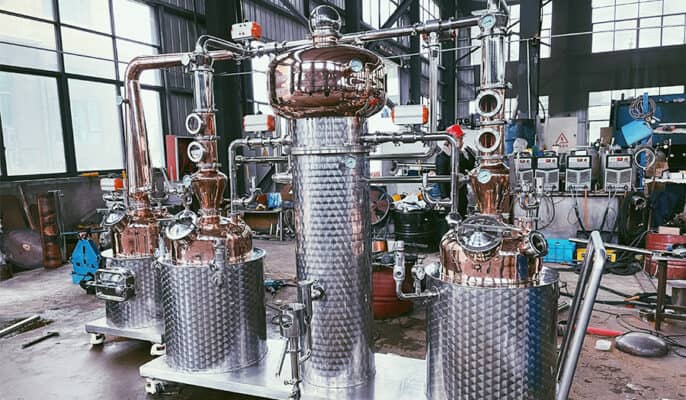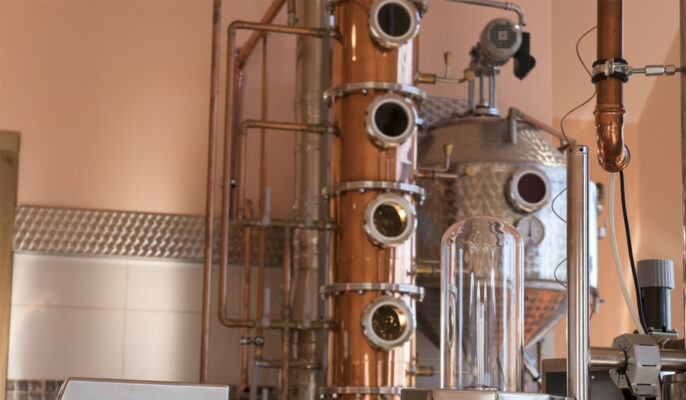Brandy ist ein gealterter Obstbrand, der für einen guten Geschmack destilliert wird und eine sehr lange Geschichte hat. Brandy ist eine Spirituose, die aus Fruchtpüree oder Wein destilliert wird. Für die Herstellung von Brandy wird eine Vielzahl von Früchten verwendet, darunter Trauben, Äpfel und Pfirsiche. Im Gegensatz zu Whiskey und Bourbon, die aus verschiedenen Getreidesorten hergestellt werden, wird Brandy jedoch immer aus reinem Fruchtpüree hergestellt. Er ist wegen seines einzigartigen Geschmacks und Aromas beliebt. Als Hersteller von Brauereimaschinen wissen wir, wie komplex und technisch anspruchsvoll die Herstellung von Branntwein ist. In diesem Artikel werfen wir einen genaueren Blick auf die Herstellung von Branntwein und die dafür erforderlichen Destillationsanlagen.
Was sind Branntweindestillate?
Branntweindestillat ist eine Spirituose auf Fruchtbasis, die durch einen Gärungs- und Destillationsprozess hergestellt wird. Der Name "Brandy" stammt von dem niederländischen Wort "brandewijn", das den Destillationsprozess widerspiegelt. Traditionell wird Brandy aus Trauben hergestellt, aber auch andere Früchte wie Äpfel, Birnen und Kirschen können verwendet werden. Die Wahl der Zutaten hat einen großen Einfluss auf den Geschmack und die Qualität der fertigen Spirituose. Die behandelten Früchte (in der Regel zu Püree gepresst) werden zur Gärung mit Hefe vermischt.
Die Hefe wandelt den Zucker in der Frucht in Alkohol um und erzeugt eine kleine Menge Kohlendioxid. Die vergorene Flüssigkeit (Obstwein) wird erhitzt, und der Alkohol verdampft und kondensiert in einem als Destillation bezeichneten Prozess durch einen Kondensator zu einer Flüssigkeit. Der Hauptzweck der Destillation besteht darin, den Alkohol zu konzentrieren und ihm die Geschmackskomponenten zu entziehen. Brandy wird in der Regel in Eichenfässern gereift, was seinen Geschmack noch komplexer macht und ihm eine besondere Farbe und Textur verleiht. Die Reifezeit variiert je nach dem gewünschten Geschmacksprofil zwischen einigen Monaten und einigen Jahren.

Verschiedene Arten von Branntwein
Jede Art von Brandy ist einzigartig; die Art der verwendeten Früchte, die Destillationsmethode und der Jahrgang bestimmen das Geschmacksprofil.
- Cognac: Dieser in der französischen Region Cognac hergestellte Branntwein wird aus Weißwein hergestellt, der zu Branntwein destilliert wird und anschließend mindestens 2 Jahre lang in Eichenfässern reift.
- Armagnac: Ähnlich wie Cognac, aber länger gereift für tiefere Aromen und ein unwiderstehlich weiches Erlebnis, ist Armagnac auf der ganzen Welt beliebt.
- Obstbranntwein: Dieser Branntwein wird aus einer Vielzahl von Früchten wie Äpfeln, Kirschen oder Pfirsichen hergestellt.
- Pisco: Pisco ist ein südamerikanischer Branntwein, der aus Trauben hergestellt wird, die in der Regel nicht gealtert werden, was zu einer klaren, frischen Spirituose führt.
Wenn Sie diese Arten kennen, können Sie besser entscheiden, welchen Brand Sie herstellen möchten. Sie haben die Wahl, ob Sie einen traditionellen Traubenbrand herstellen oder einen anderen Obstbrand ausprobieren möchten.
Unverzichtbare Ausrüstung für die Herstellung von Branntwein
Fermenter
Der Gärbehälter ist das wichtigste Gerät, das den Saft und die Hefe aufnimmt und eine kontrollierte Umgebung bietet, in der die Hefe den Zucker in Alkohol umwandeln kann. Gärbehälter sind in der Regel aus rostfreiem Stahl, und der Tank sollte gut abgedichtet sein, um Verunreinigungen von außen zu verhindern. Wählen Sie je nach Produktionsumfang Tanks mit einem angemessenen Fassungsvermögen, um das Gärungsvolumen aufzunehmen.
Ausrüstung für die Destillation
Destillationsgeräte werden verwendet, um Wein zu Branntwein zu destillieren. Es gibt viele Arten von Destillierapparaten, von einfachen Pot Stills bis zu komplexeren Column Stills.
- Destillateure: Die Gärflüssigkeit wird erhitzt, um den Alkohol und andere flüchtige Stoffe zu verdampfen, die über einen Kondensator zu einer Flüssigkeit kondensiert werden, um die gewünschten Schnapskomponenten zu trennen. Er sollte über ein Heizsystem, ein Kondensationssystem und eine Auffangvorrichtung verfügen. Die Konstruktion muss den thermodynamischen Anforderungen der Destillation entsprechen, um die Effizienz zu verbessern.
- Kondensator: kühlt und kondensiert die verdampften Alkoholdämpfe zu einer Flüssigkeit. Gängige Arten von Kondensatoren sind Schlangenkondensatoren und Röhrenkondensatoren. Die Wahl des richtigen Kondensators kann die Kondensationseffizienz verbessern.
- Heizsystem: Die Erhitzung der destillierten Flüssigkeit sorgt für ausreichend Wärme, um den Alkohol zu verdampfen, in der Regel durch Dampf-, Elektro- oder Flammenerhitzung. Es sollte eine Temperaturregelung vorhanden sein, um die Verdampfungstemperatur genau zu regulieren. Die Genauigkeit der Temperaturregelung ist entscheidend für die Qualität der Destillation.
- Fraktionierungssäulen: Fraktionierkolonnen enthalten in der Regel mehrere Fraktionierscheiben oder Packungen, um die Trennung zu verbessern. Geeignet für High-End-Destillationsanlagen. Trennt Alkohol und andere flüchtige Stoffe weiter ab, um die Reinheit und den Geschmack des Alkohols zu verbessern.
- Sammlungseinheit: Die Destillatsammelstelle trennt die verschiedenen Destillationsstufen, einschließlich des Kopfteils, des Herzteils und des Endteils. Sie ist mit einer Umleitungsfunktion ausgestattet, um die verschiedenen Destillationsstufen genau zu trennen. Die Herzsektion ist das Herzstück der Brandweinherstellung. Verwenden Sie zum Auffangen der verschiedenen Teile des Destillats korrosionsbeständige Behälter, um eine Verunreinigung zu vermeiden.
Messgerät für das spezifische Gewicht
Bei der Herstellung von Branntwein ist das Messgerät für das spezifische Gewicht ein wichtiges Instrument zur Messung der Dichte und des Zuckergehalts der Gärflüssigkeit. Durch die Überwachung dieser Parameter ist es möglich, den Gärungsprozess effektiv zu steuern, die Produktionsschritte zu optimieren und die Qualität des Endprodukts sicherzustellen. Durch die Überwachung der Veränderung des spezifischen Gewichts während des Gärungsprozesses können Sie erkennen, ob die Gärung ordnungsgemäß verläuft. Wenn die Veränderung des spezifischen Gewichts langsam ist oder stagniert, kann es notwendig sein, die Gärbedingungen anzupassen oder die Gesundheit der Hefe zu überprüfen.
Alternde Gefäße
Das Reifegefäß ist ein sehr wichtiges Gerät bei der Herstellung von Branntwein, das sich direkt auf den Geschmack, die Farbe und die Textur des Endprodukts auswirkt. Edelstahlbehälter werden für die stabile Lagerung von Branntwein während des Reifungsprozesses verwendet, um den Kontakt mit Luft zu vermeiden und die Reinheit der Spirituose zu erhalten. Die Verwendung hochwertiger Lagertanks aus Edelstahl erfordert eine gute Abdichtung, Korrosionsbeständigkeit und leichte Reinigung. Auf diese Weise wird das Eindringen von Luft verhindert und die Stabilität der Spirituose aufrechterhalten.

Der Herstellungsprozess von Branntwein
- Auswahl der Rohstoffe: Die Qualität des Branntweins hängt weitgehend von den verwendeten Rohstoffen ab. Traditionell wird Branntwein hauptsächlich aus Trauben hergestellt, aber auch andere Früchte wie Äpfel und Birnen können verwendet werden. Die Rohstoffe müssen frisch und reif sein, um eine optimale Gärung und Destillation zu gewährleisten.
- Gärungsprozess: Wählen Sie einen geeigneten Gärtank, in der Regel aus Edelstahl oder Eichenholz, und lassen Sie die gereinigten Früchte durch einen Zerkleinerer laufen, um das Püree zu verarbeiten und seine Oberfläche zu vergrößern, um die Gärung zu fördern. Der Tank sollte gut abdichten, um die Gärumgebung zu kontrollieren.
- Destillationsverfahren: Die Destillateure wählen hochwertige Destillierapparate aus Kupfer oder rostfreiem Stahl. Kupferbrennblasen können Sulfide entfernen und den Geschmack verbessern; die Gärflüssigkeit wird in die Brennblase gegossen und erhitzt, bis der Alkohol verdampft. Der anfänglich verdampfte Alkohol (Kopfteil) enthält viele unerwünschte Stoffe und sollte verworfen werden. Der in der Mitte verdampfte Alkohol (Herzteil) ist das Herzstück eines hochwertigen Branntweins, während der am Ende verdampfte Alkohol (Schwanzteil) in der Regel mehr Verunreinigungen enthält und je nach Bedarf zurückbehalten werden muss oder nicht.
- Sammeln: Je nach Stadium der Destillation werden verschiedene Teile des Alkohols gesammelt. Der Herzteil wird in der Regel für die Herstellung des Endprodukts verwendet.
- Reifungsprozess: Während des Reifungsprozesses müssen Temperatur und Feuchtigkeit kontrolliert werden. Die Lagerungsumgebung sollte bei konstanter Temperatur und mäßiger Luftfeuchtigkeit gehalten werden, um ein Austrocknen der Fässer oder eine übermäßige Verflüchtigung des Branntweins zu vermeiden. Nach der Reifung kann eine Filtration erforderlich sein, um Verunreinigungen zu entfernen und die Alkoholkonzentration und den Geschmack nach Bedarf anzupassen.
- Abfüllen und Verpacken: für die präzise Abfüllung des gereiften Branntweins in Flaschen. Eine automatische Abfüllmaschine verbessert die Effizienz und sorgt dafür, dass das Volumen des Schnapses von Flasche zu Flasche gleich bleibt. Eine Flaschenverschließmaschine wird zum Verschließen der Flaschenmündung eingesetzt, um die Dichtigkeit und Stabilität des Produkts zu gewährleisten.
Schlussfolgerung
Die Herstellung von Branntwein ist ein komplexer Prozess, der eine hochwertige Ausrüstung und eine strenge Kontrolle bei jedem Schritt erfordert, von der Vorbereitung des Rohmaterials über die Gärung, Destillation und Reifung bis hin zur Abfüllung. Als Hersteller von Brauereianlagen hat sich die micet Gruppe verpflichtet, hochmoderne Anlagen und Technologien zu liefern, die Brennern helfen, in jeder Phase optimale Ergebnisse zu erzielen. Wenn Sie Fragen zu unseren Anlagen haben oder weitere technische Unterstützung benötigen, können Sie sich gerne an uns wenden.
FAQ
Welche Geräte werden hauptsächlich zur Herstellung von Branntwein verwendet?
- Geräte zur Verarbeitung von Obst: Zum Beispiel Waschmaschinen, Zerkleinerungsmaschinen, Saftpressen.
- Fermentationsanlagen: Fermenter, Temperaturkontrollsysteme, Rührwerke.
- Destillationsanlagen: Destillierapparate, Kondensatoren, Fraktionierungstürme (optional), Heizsysteme.
- Reifungsausrüstung: Eichenfässer, Behälter aus rostfreiem Stahl.
- Filtrations- und Mischanlagen: Filter, Mischsysteme.
- Abfüll- und Verpackungsanlagen: Abfüllmaschinen, Flaschenverschließer, Etikettiermaschinen, Verpackungsmaschinen.
Wie wähle ich den richtigen Gärbehälter?
In der Regel sind sie aus Edelstahl oder Eiche. Tanks aus rostfreiem Stahl sind korrosionsbeständig und leicht zu reinigen, während Tanks aus Eichenholz zur Geschmacksverstärkung beitragen. Wählen Sie das richtige Fassungsvermögen entsprechend Ihrem Produktionsumfang.
Was sind die Kriterien für die Auswahl von Destillationsanlagen?
- Material: Kupfergeräte helfen, unerwünschte Sulfide zu entfernen und verbessern den Geschmack. Geräte aus Edelstahl sind korrosionsbeständig und leicht zu reinigen.
- Heizsystem: Achten Sie bei der Wahl des Heizsystems (z. B. Dampf oder Elektro) darauf, dass die Temperatur genau geregelt werden kann.
- Verflüssiger: Die effiziente Konstruktion des Kondensators gewährleistet eine angemessene Kondensation der Alkoholdämpfe.
- Fraktionierer: Für die High-End-Produktion können Fraktionatoren die Reinheit des Alkohols weiter verbessern.
Wie kann ich die Geschmacksqualität meines Branntweins bestimmen?
Die Komplexität und Ausgewogenheit der Aromen kann durch eine sensorische Bewertung durch einen professionellen Sommelier festgestellt werden. Alkoholgehalt, Säuregehalt, Zucker und andere Indikatoren können auch durch eine chemische Analyse geprüft werden.




